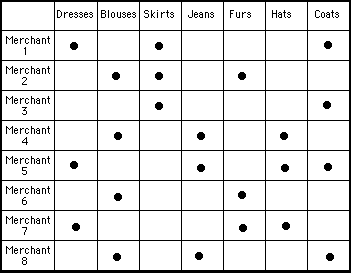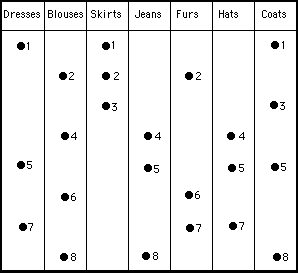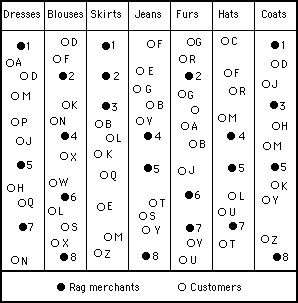
Chapter 9
A formatted people space
Formatting a people space
In the bricks and mortar world example, of using rag merchants in a system to extract 1920's and 1930's clothing from all the garments discarded every week in England, it is natural to think of the entrepreneur as the sole collector and organiser. All garments would be selectively filtered to the entrepreneur's central base for redistribution to the customers.
Using a paradigm shift, now imagine that it is not the organising entrepreneur who is using such a system to filter garments, but, the customers - each of whom would have their own set of rag merchants to obtain garments exclusively for themselves. In this way, the customers would be able to order exactly what they wanted without having to be limited to the selections chosen by the entrepreneur.
If the customers used the system themselves, the entrepreneur wouldn't have to deal with the rag merchants, nor the customers or their orders. In fact the entrepreneur wouldn't even have to know what the customer wanted or what the rag merchants were supplying. The entrepreneur would be completely outside of the system. It would be completely self organising, with customers going directly to the rag merchants and the rag merchants supplying directly to the customers.
This begs the question: "What would be the role of the entrepreneur?"
To answer this question, it is necessary to consider the main problem each customer would have to face before they could take advantage of this system. How would they find and make contact with rag merchants on their own?. Where would they find those that would be interested in sorting out the particular garments they wanted? The rag merchants would have a similar problem: how would they find the customers who were wanting the kind of garments they were sorting?
From this view point, it is easy to see that the role of an entrepreneur in such a self organising system of supply and demand would be to provide an infrastructure to make it easy for people to find each other.
In the bricks and mortar world of real rag merchants, customers would be able to find rag merchants if an entrepreneur created a directory: listing all rag merchants and their contact details, together with a description of the garments they were sorting. This could be represented as a table: a two dimensional space divided up into rows and columns, as illustrated in figure 9.3. Dots in this diagram represent either:
1) The garments each merchant sorts, or,
2) The rag merchants that sort any particular listed garment

Figure 9.3
Using rows and columns a two dimensional space is created. Each dot in the space represents a merchant (identified by the name in the row) who is sorting out a particular type of article (specified by the description of the column)
The trick now is to imagine each dot in this space as representing a merchant. Conceptually, the diagram then stops being a table and becomes a number of boxes that contain merchants. For example, the part of the space reserved for blouses (the blouses column) becomes a box that contains every rag merchant who sorts out blouses.
If somebody wants blouses, they can be imagined as visiting the box allocated to blouses (the blouse column) where they will find all the merchants in the country who are sorting out blouses.
This situation is illustrated in figure 9.4, where the rag merchants are identified with a reference number (eliminating the need to have them represented as rows in a table).

Figure 9.4
Each category of garment can be thought of as a box that contains several rag merchants. Any rag merchant (each identified by a reference number) can be in several boxes at the same time
In the same way as a merchant can be represented as a dot in a garment space, so can a buyer. Figure 9.5 shows a mixture of merchants and buyers visiting the space allocated to a type of garment that is being sorted or bought. Merchants are identified with numbers and buyers are identified with letters. Using these identifications to obtain the necessary contact details, merchants and buyers can visit an appropriate box to communicate with each other directly.
Conceptually, it is as if the people in each of these garment spaces (boxes) were together in a virtual cafe, where they'd each be free to wander around and talk to each other. Thus, instead of a seeing a tabular representation, you have a picture in your mind of a number of cafes – each attracting a uniquely different group of people who have a particular niche interest.

Figure 9.5
Buyers can be thought of as visiting garment spaces to find rag merchants. Rag merchants can be thought of as visiting the spaces to find buyers for the garments they are sorting. Each garment space can be thought of as a virtual cafe where those present can talk to each other
Using conventional thinking, it is impossible to imagine a database without algorithms that store, sort and search for information. It would seem impossible that a database could construct itself without a team of people entering in all the data. Yet, from figure 9.5, it is easy to see how there wouldn't be any need for algorithms or management – if only rag merchants and buyers were given facilities to enter their own presence in any of the garment spaces.
For example, new rag merchants starting up in business could simply enter their presence into the spaces associated with the articles they were sorting. It would immediately put them into contact with all the buyers who would be looking for those particular garments. They could also enter garment spaces to find out how many people were looking for particular types of garment, giving them a guide as to what garments would be the most profitable to sort..
Similarly, a buyer could enter their presence into the spaces associated with the garments they were interested in obtaining. This would put them in contact with all the rag merchants who were sorting those items.
There wouldn't be a requirement for sorting or searching algorithms on the database side because all the entering and retrieving of data would be done by the rag merchants and buyers when they decided where to enter their presence. Merchants and buyers could add or remove their presence from various different garment spaces, as and when their respective sorting or buying patterns changed.
If merchants and customers are also allowed to add extra columns, to specify additional garments that are being sorted or are wanted, the whole database could be run by the users themselves without the need for any building or maintenance from the server side. In fact, the server side needn't even have any direct contact with the users – because through a self organisation process they would be able to make all the appropriate contacts themselves.
Would such a system work? There is a very good precedence. Napster, the peer to peer networking phenomenon that threatened to bring down the entire music publishing industry worked on a similar principle. During the dotcom bubble at the turn of the century, while other startups were obtaining millions of dollars in funding and failing spectacularly to create viable information systems, Napster, with virtually no capital and little organisation, attracted 12 million people who used Napster's very simple peer to peer networking system to exchange music with each other. Napster did very little more than provide a way for people of similar interests to get in contact with each other directly - and they didn't even format the people space.